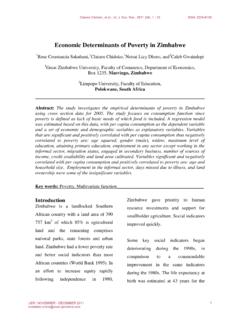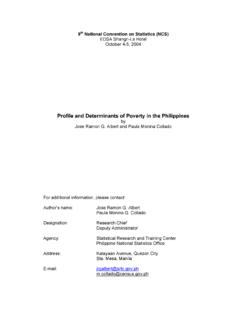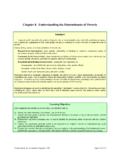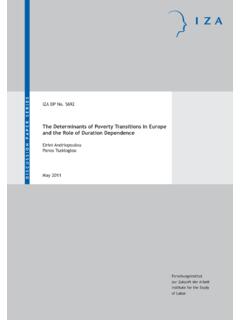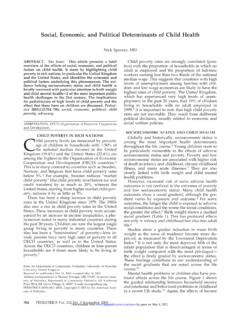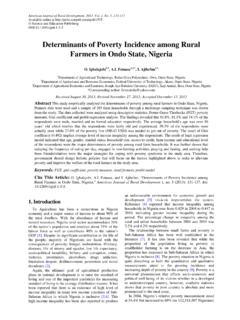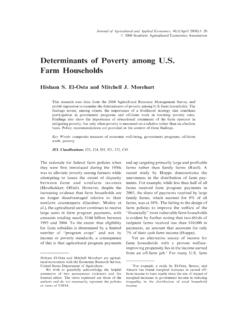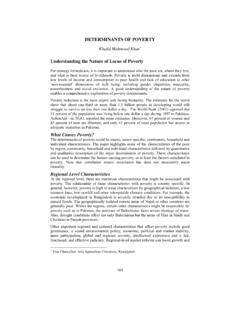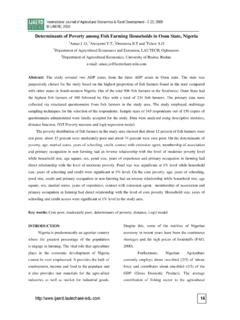Transcription of Examining the Structural Determinants of Poverty,
1 AMERICANPSYCHOLOGICALASSOCIATIONCOMMITTE E ON SOCIOECONOMIC STATUSE xamining the Structural Determinants of poverty , an Annotated BibliographyJuly 2013 The APA Committee on Socioeconomic Status laura Smith, PhD, Teachers College, Columbia university Cynthia Hudley, PhD, university of California, Santa Barbara Dionne Jones, PhD, National Institute on Drug Abuse Salvador Macias, III, PhD, university of South Carolina, Sumter Ruth Riding-Malon, PhD, Radford university John Ruiz, PhD, university of North Texas APA Staff Public Interest Directorate Office on Socioeconomic Status Keyona King-Tsikata, Director Ieshia HaynieThe APA Office on Socioeconomic Status wishes to acknowledge research consultant Ann Kim, university of California, Santa Barbara, and the many APA staff members whose design and communication skills critically helped us achieve this goal: Efua Andoh, Angela Grohman, Farzana Saleem, David Spears, and Joanne Zaslow.
2 Examining the Structural Determinants of poverty , an Annotated Bibliography 1 About the APA Committee on Socioeconomic Status The mission of the Committee on Socioeconomic Status (CSES) shall be to fur-ther the major purpose of the American Psychological Association to advance psychology as a science and a profession and as a means of promoting health, education, and human welfare by ensuring that issues of socioeconomic status receive the full attention of the association. The committee will identify and act as a catalyst in the association s efforts to address issues of SES and promote appro-priate attention to SES in psychological research and practice.
3 In this regard, the committee shall: (a) collect information and documentation concerning SES;(b) promote scientific understanding of the roles of poverty and SES in health, education, and human welfare;(c) develop approaches to the application of psychology that take into account the effects of SES on psychological development and well-being; and(d) advocate for social policy that will alleviate or reduce the disparities between SES groups. 2 The Office of Socioeconomic Status is pleased to provide this annotated bibliog-raphy of resources that provide information about the Structural Determinants of poverty in the United States.
4 The annotation for each reference listed in the bibliog-raphy provides a brief summary of the item s contents. The bibliography contains listings of relevant books, research and technical reports, and scholarly literature. Given the large amount of literature on this topic, this bibliography provides only a purposeful sampling. In searching for materials to include in the bibliography, researchers carried out keyword searches of several major social science databases and of websites of federally funded poverty research centers in the The research centers examined included those housed at the University of California, Davis (UC Davis Center for poverty Research); the University of Kansas (UK Center for poverty Research), the University of Wisconsin (Institute for Research on poverty ); and Stanford University (Stanford Center on poverty and Inequality).
5 The search intentionally excluded materials published prior to the 1996 Welfare Reform ACT, as that landmark legislation clearly altered the Structural landscape in this country. Certain acronyms are used throughout the bibliography. They are: DI: Disability Insurance EITC: Earned Income Tax Credit PR WOR A : The Personal Responsibility and Work Opportunity Reconciliation Act (typically referred to as The 1996 Welfare Reform Act ) SNAP: Supplemental Nutrition Assistance Program (typically known as the Food Stamp Program: FSP) SSI: Supplemental Security Income TAN F: Temporary Assistance for Needy Families (successor to Aid to Families With Dependent Children: AFDC) uI: Unemployment Insurance 3 BooksEdelman, P.
6 (2012). So rich, so poor: Why the wealthiest nation in the world is losing the battle against poverty . New york, Ny: The New book is a concise (162 pages exclusive of notes and references), comprehensive overview of the Structural circumstances that contribute to poverty in America. The author first skillfully uses facts and figures to lay out the state of the national economy and its attendant impact on poverty from the late 1960s to about 2010. The greater part of the book looks at the many efforts the nation has undertaken, primarily at the federal and state levels, but also at the municipal and community levels, to bring public policy to bear on the intractable problem of poverty .
7 The slim volume manages to cover a host of topics that include employment policy (the 40-year drought of good jobs ), housing policy, education policy, welfare policy, and criminal justice policy. Of note, the author has a long personal history working in this field as a prominent antipoverty activist and scholar who famously resigned from the Clinton administration in protest over the near abolition of wel-fare. This is an excellent overview of the dire condition of the American economy and the state of governments efforts to address poverty in the last five decades. 4 Collings, J. l., & Mayer, V.
8 (2010). Both hands tied: Welfare reform and the race to the bottom of the low-wage labor market. Chicago, Il: university of Chicago. This succinct book (164 pages exclusive of notes and references) is an overview of the consequences of welfare reform, or workfare, and its effects on welfare recipients. Weaving together stories of 33 women who received welfare support, their situation in the local labor market, and the national and global economy, the authors discuss the great obstacles faced by women to pull themselves and their families out of poverty . Welfare reform provisions place women in low-wage jobs with no sick or paid leave, and, due to their working status, the women lose child care support.
9 Cash assistance requires women to be placed irrespective of their skills or training, and they are unable to decline an offered position unless they reject cash , K. S., & O Brien, R. (2011). Taxing the poor: Doing damage to the truly disadvantaged. Berkley and los Angeles: university of California book brings to light tax policies in the United States, particularly in the American South and West, which are particularly detrimental to the poor. In some states, poor families pay not only income taxes but also regressive sales taxes that apply even to food for home consumption. As the authors describe, decades before California s much ballyhooed passage of Proposition 13, many southern states had already initiated tax structures that kept property and corporate taxes artificially low.
10 Instead, the sales taxes intended to replace uncollected revenue from prop-erty and business owners are extremely regressive and punish the poor. This book documents the historical progression of a tax policy that exacerbates the circum-stances of the impoverished, contributing in often unrecognized ways to problems like obesity, early mortality, high school dropout, teen pregnancy, and crime. 5 Shipler, D. K. (2004). The working poor: The invisible in America. New york, Ny: Alfred A. Knopf. The Working Poor (300 pages exclusive of notes and references) shatters the percep-tion that America is a country in which prosperity and security are the inevitable rewards of gainful employment.










